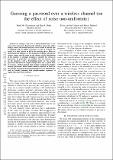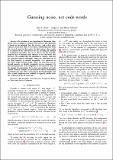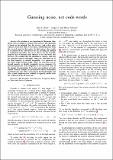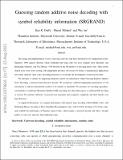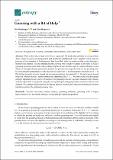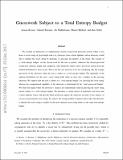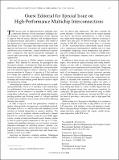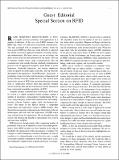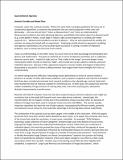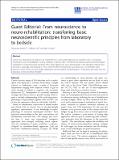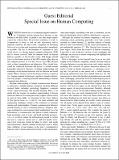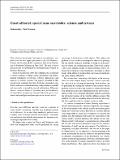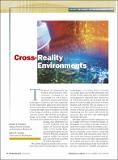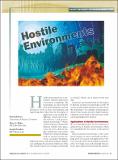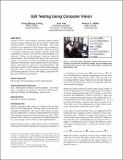Browsing MIT Open Access Articles by Title
Now showing items 20356-20375 of 55773
-
Guessing a password over a wireless channel (on the effect of noise non-uniformity)
(Institute of Electrical and Electronics Engineers (IEEE), 2013-11)A string is sent over a noisy channel that erases some of its characters. Knowing the statistical properties of the string's source and which characters were erased, a listener that is equipped with an ability to test the ... -
Guessing noise, not code-words
(IEEE, 2018-06)© 2018 IEEE. We introduce a new algorithm for Maximum Likelihood (ML) decoding for channels with memory. The algorithm is based on the principle that the receiver rank orders noise sequences from most likely to least likely. ... -
Guessing noise, not code-words
(IEEE, 2018-06)© 2018 IEEE. We introduce a new algorithm for Maximum Likelihood (ML) decoding for channels with memory. The algorithm is based on the principle that the receiver rank orders noise sequences from most likely to least likely. ... -
Guessing random additive noise decoding with symbol reliability information (SRGRAND)
(Institute of Electrical and Electronics Engineers (IEEE), 2022) -
Guessing with a bit of help
(MDPI, 2019-12)What is the value of just a few bits to a guesser? We study this problem in a setup where Alice wishes to guess an independent and identically distributed (i.i.d.) random vector and can procure a fixed number of k information ... -
Guesswork Subject to a Total Entropy Budget
(Institute of Electrical and Electronics Engineers (IEEE), 2017-10)© 2017 IEEE. We consider an abstraction of computational security in password protected systems where a user draws a secret string of given length with i.i.d. characters from a finite alphabet, and an adversary would like ... -
Guest Editorial for Special Issue on High-Performance Multichip Interconnections
(Institute of Electrical and Electronics Engineers, 2010-05)The ten papers in this special issue focus on high-performance multichip interconnections. The papers span novel transmitter and receiver equalization and data-recovery architectures, channel architecture organizations, ... -
Guest Editorial Special Issue on Electronic Voting
(Institute of Electrical and Electronics Engineers, 2009-11)The 13 papers in this special issue focus on electronic voting. -
Guest editorial special section on RFID
(Institute of Electrical and Electronics Engineers, 2009-01)The eight articles in this special section describe state-of-the-art technologies and tools and one application of RFID. -
Guest Editorial: Big Data
(Springer US, 2016-06)Computer vision has a split personality. Within the same field, and largely guided by the same set of fundamental algorithms, it combines two problems that are utterly disparate in their aims and philosophy—here we will ... -
Guest Editorial: From neuroscience to neuro-rehabilitation: transferring basic neuroscientific principles from laboratory to bedside
(BioMed Central Ltd., 2013-01)Several new approaches for treatment of Central Nervous System (CNS) disorders are currently under investigation, including the use of rehabilitation training strategies, which are often combined with electrical and/or ... -
Guest Editorial: From neuroscience to neuro-rehabilitation: transferring basic neuroscientific principles from laboratory to bedside
(Biomed Central Ltd., 2013-01)Several new approaches for treatment of Central Nervous System (CNS) disorders are currently under investigation, including the use of rehabilitation training strategies, which are often combined with electrical and/or ... -
Guest Editorial: Scene Understanding
(Springer US, 2015-03)Scene understanding is the ability to visually analyze a scene to answer questions such as: What is happening? Why is it happening? What will happen next? What should I do? For example, in the context of driving safety, ... -
Guest editorial: Special issue on human computing
(Institute of Electrical and Electronics Engineers, 2009-02)The seven articles in this special issue focus on human computing. Most focus on two challenging issues in human computing, namely, machine analysis of human behavior in group interactions and context-sensitive modeling. -
Guest editorial: special issue on robotics: science and systems
(Springer US, 2012-06)This volume is the second of two special journal issues compiled from the best papers presented at the fifth Robotics: Science and Systems (RSS) conference, held at the University of Southern California in June 2011. The ... -
Guest Editors' Introduction to the Special Section on Probabilistic Graphical Models
(Institute of Electrical and Electronics Engineers, 2009-08)The ten papers in this special section focus on applications of probabilistic graphical models in all areas of computer vision. -
Guest Editors' Introduction: Cross reality environments
(IEEE Computer Society, 2009-07)In this article, we define cross-reality as the union between ubiquitous sensor/actuator networks and shared online virtual worlds-a place where collective human perception meets the machines' view of pervasive computing. ... -
Guest Editors' Introduction: Hostile Environments
(IEEE Computer Society, 2010-09)Pervasive computing technology can save lives by both eliminating the need for humans to work in hostile environments and supporting them when they do. In general, environments that are hazardous to humans are hard on ... -
Guest Editors' Introduction: Unpacking a Controversy: National Histories, Visual Cultures, and Digital Dissent
(Duke University Press, 2015-04)This special issue reflects upon the student protest and public controversy over the Massachusetts Institute of Technology (MIT) Visualizing Cultures website in 2006 from multiple perspectives. Three sets of questions ... -
GUI Testing Using Computer Vision
(Association for Computing Machinery (ACM), 2010-04)Testing a GUI's visual behavior typically requires human testers to interact with the GUI and to observe whether the expected results of interaction are presented. This paper presents a new approach to GUI testing using ...

